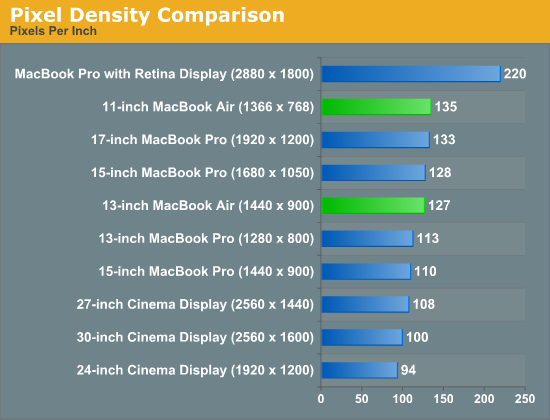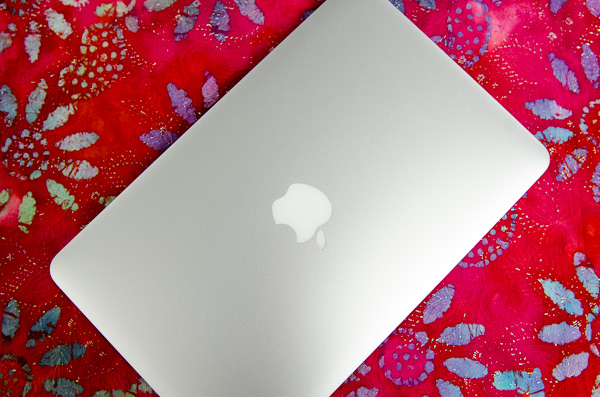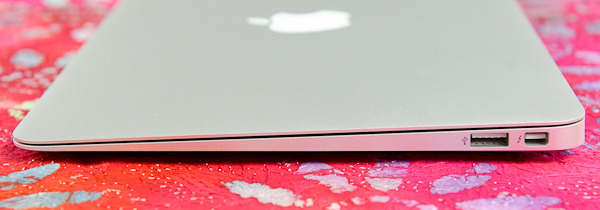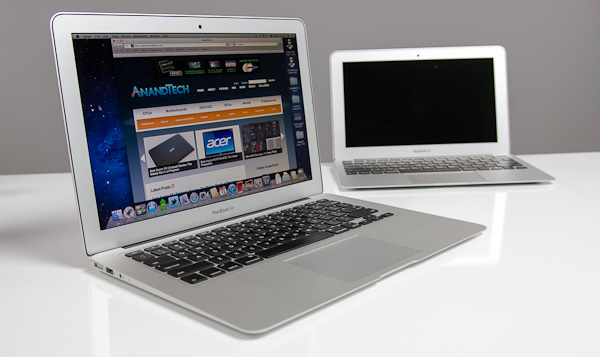The 2012 MacBook Air (11 & 13-inch) Review
by Anand Lal Shimpi on July 16, 2012 12:53 PM EST- Posted in
- Apple
- Mac
- MacBook Air
- Laptops
- Notebooks
Things are getting very blurry.
The MacBook Pro once stood for tons of power plus upgradability. Add a Retina Display and now it's just tons of power. It's a thicker, faster MacBook Air (with an awesome display). It's not bad, in fact it's quite amazing, but it confuses the general order of things.
The MacBook Air doesn't help in the clarity department. You can now order a MacBook Air with up to 8GB of RAM and a 512GB SSD, for the first time in MacBook Air history. Users who were once forced into Pro territory because of RAM and storage requirements can now happily live with an Air. And thanks to Turbo Boost, you do get similar performance in lightly threaded workloads.
Take a step away from the Mac world and you'll see the rest of the market is going through its own confusing period. Nearly every single Microsoft partner is mixing tablets and Ultrabooks. If your tablet uses smartphone hardware, and can dock into a notebook or Thunderbolt itself into a desktop, is all of this a lot of confusion before client computing moves entirely to smartphones? NVIDIA said it would happen publicly (even Intel did so privately a few years ago). Maybe it wasn't just convenient rhetoric. Maybe that's where we're headed. Until then, there are going to be a lot of different form factors, all with very compelling features. The MacBook Air continues to be one of them.
Despite the recent Ultrabook frenzy, the MacBook Air was one of the first (if not the first) to marry performance with usability, screen size/resolution, portability and battery life. Ultraportables prior to the MacBook Air's arrival in 2008 typically sacrificed in one or more of the above areas. I spent years in pursuit of the perfect ultraportable in college over a decade ago (30 is the new 20 right?), and generally came away disappointed and empty handed.
In 2010 Apple changed the expectations of cost with the MacBook Air. The new 11-inch model would start at just $999. And the 13-inch would only cost $300 more. The very first MacBook Air, by comparison, retailed for $1800. Apple took an ultraportable and made it its mainstream notebook. It was a bold move but one that was very forward looking.
Today the MacBook Air is even more affordable. The 11-inch model still starts at $999, but the 13-inch version is only $200 more. From the outside not a lot has changed, but that doesn't mean there's any less to talk about. Ivy Bridge, USB 3.0 and faster SSDs are all on the menu this year. Let's get to it.
The 11 & 13
Unlike the other thin member of Apple's Mac lineup, the MacBook Air chassis hasn't changed over the past three years. Since the 2010 update that gave us the 11-inch model and significantly lower prices, Apple has stuck with a design that only recently has seen widespread emulation.
While our last review focused on the beginning of a new generation, this review takes a look at a very mature, yet still very good design. The MacBook Air is just so pleasant to carry around. It'll make even the new rMBP feel like a pig.
Both the 11 and 13-inch models are effortless to carry around. While I dread traveling with a traditional notebook, slipping one of these into my backpack is barely noticeable. You can get used to and take for granted just about anything, but the form factor of the MacBook Air continues to be a favorite of mine even today.

The 11-inch MacBook Air is a great option for those who want the portability of a tablet but find themselves wanting to attach a keyboard to it most of the time. The 11.6-inch display boasts the highest pixel density of all of Apple's non-retina displays at 1366 x 768, but it's still quite usable. You don't make any sacrifices on keyboard size or key spacing (it's identical to the 13-inch model for the majority of the keys), nor do you have to give up any performance either. Apple offers all of the same CPU, memory and storage upgrades across both MacBook Airs. And with no discrete GPU, thermal throttling isn't really a problem either in the 11-inch chassis. With Thunderbolt, the 11-inch MacBook Air can actually give you the best of both worlds: an incredibly portable computer when you're on the go, and enough to act as your desktop when docked to a Thunderbolt Display.
I've traditionally always bought the 11-inch MacBook Air with the thought that I'd carry it when I didn't need to lug around my MacBook Pro. I seemed to be fooling myself however as over 90% of the time I'd end up with the MacBook Pro. The 11-inch Air was relegated to typewriter duty when I needed a change of scenery while writing at home. It's a great writer's companion, but if I couldn't have more than one system I'd have to opt for its bigger brother.
When I first reviewed the redesigned 13-inch MacBook Air I wrote that it felt more like a normal notebook, while the 11 was something a bit more unique. Perhaps I was more infatuated with the new 11 at the time, because these days I'm more drawn to the 13-inch MacBook Air as the notebook to have if you can only have one.
You get a 23.5% increase in screen resolution on a display that's just easier to look at. While 1440 x 900 is a bit much on a 15-inch MacBook Pro, I'd say it's near perfect on the 13-inch Air. If Apple were to do the Retina treatment on here, it'd be magnificent.
The larger chassis allows room for an SD card reader, which is thankfully quite functional. Otherwise the port layout is identical to the 11-inch model.
| 2012 MacBook Air Lineup | ||||||
| 11.6-inch | 11.6-inch (high-end) | 13.3-inch | 13.3-inch (high-end) | |||
| Dimensions |
H: 0.11-0.68" (0.3-1.7cm) W: 11.8" (30cm) D: 7.56" (19.2cm) |
H: 0.11-0.68" (0.3-1.7cm) W: 12.8" (32.5cm) D: 8.94" (22.7cm) |
||||
| Weight | 2.38 lbs (1.08kg) | 2.96 lbs (1.35kg) | ||||
| Cores/Threads | 1.7GHz dual-core Core i5 | 1.8GHz dual-core Core i5 | ||||
| Base Clock Speed | Intel HD 4000 | |||||
| RAM | 4GB DDR3L-1600 | |||||
| SSD | 64GB SSD | 128GB SSD | 128GB SSD | 256GB SSD | ||
| Display Resolution | 1366 x 768 | 1440 x 900 | ||||
| Ports | Thunderbolt, 2x USB 3.0, headphone jack | Thunderbolt, 2x USB 3.0, SD card slot, headphone jack | ||||
| Price | $999 | $1099 | $1199 | $1499 | ||
In its role as a proponent of simplicity, Apple has reduced the decision between what Air to get down to screen size, resolution and battery life (the 13-inch chassis houses a much larger battery). If you like having more of all of those things, the 13-inch Air is for you. If carrying anything larger than a tablet upsets you, buy the 11.




















190 Comments
View All Comments
G3t/All - Monday, July 16, 2012 - link
If by games you mean very light duty stuff then yes. It uses an Intel HD4000 graphics chip which translates into no discrete graphics card. This is intended for mobility and not gaming performance. As far as driver problems, you can download all the windows 7 drivers from Apple, or they are included using "Boot Camp". Can't remember which. Driver issues are not the problem, the lack of a discrete graphics card is. Google whatever games your planning on playing and see what kind of framerate they return running on Intel HD4000 graphics. If those numbers are acceptable, then you should be fine.khimera2000 - Monday, July 16, 2012 - link
I avoid Intel as much as possible for gaming. Yes there graphic hardware might be improving, but I hate the bugs. Optimus never worked right on my notebook, my older notebooks always bugged out with dedicated Intel, or some other issue would creep out of the wood work.Your not getting a MacBook air for gaming, ya there's Steam but the thought of gaming on a system like this is in fifth place behind Productivity, Portability, Battery Life, and Build quality. I would go for the Pro with a dedicated Video if your prioritizing anything 3D (games or otherwise.)
KPOM - Monday, July 16, 2012 - link
Be aware of the "bug" affecting the Core i7 models. There is a workaround for the CPU (install a program called ThrottleStop 5.00 beta), but it also seems to have some impact on the GPU right now. Apple is working on a fix, but hasn't said when it will be out.KPOM - Monday, July 16, 2012 - link
The bug is that it doesn't fully enable turbo boost. The i7 is supposed to go up to 3.2GHz, but seems to be topping out around 2.4GHz.KPOM - Monday, July 16, 2012 - link
And note it is only on Windows (Turbo Boost works fine on OS X).ananduser - Monday, July 16, 2012 - link
Yes you will, but windows on a mac incurs some penalties to the battery life and overall performance of the system. Too bad Apple forces you to deal with bootcamp.CharonPDX - Monday, July 16, 2012 - link
"With the 13-inch MBA significantly outpacing even the rMBP with its 95Wh battery, while doing the exact same amount of work."I have to disagree. The MBA isn't doing the same amount of "work", it is performing under a similar effective "load".
Something tells me that if you were performing a fixed amount of work via heavily CPU/GPU-intensive tasks on both the 13" Air and the rMBP, the rMBP would get a lot more of that work done before its battery died than the Air would, even though the Air would run longer. (Say, transcoding twenty hours of HD footage using a transcoder that uses all CPU cores plus the GPU - those four cores and discrete GPU would get a lot more of that twenty hours done than the dual cores with integrated GPU.)
Karltheghost - Monday, July 16, 2012 - link
The Macbook Air is supposed to be an ultraportable, hence to be carried around the whole day. Can it stand a rough use? Since this is an ability that most new notebooks lack, i'm still stuck with my old IBM. You can close the lid, wreck a car using the Tinkpad as a club, open it again and continue working. But does the MBA work after you drop it of the table, for example?tipoo - Monday, July 16, 2012 - link
The aluminium is pretty dent prone, I've seen lots of nasty dings in aluminium macs. If the dent is deep enough it could damage something vital. The SSD does help with durability though since there are no moving heads and spinning platters to crash.GotThumbs - Monday, July 16, 2012 - link
Over the 9+ years that I've been visiting AnandTech, I've never felt more disappointed. This "Review" (reads more like a paid endorsement) lacks a sense of independent subjectivity and over flows with Fanboism.I'm really disappointed in this read.
" tons of power plus upgradability" (New technical term..."tons")
" It was a bold move but one that was very forward looking."
" If Apple were to do the Retina treatment on here, it'd be magnificent."
" If carrying anything larger than a tablet upsets you, buy the 11."
"The new 11-inch model would start at just $999. And the 13-inch would only cost $300 more. The very first MacBook Air, by comparison, retailed for $1800"
Anyone with a brain knows that by Apple using its existing parts bins (the case and what ever else) over 3 years and factoring the scale of economics....the cost was overdue for being dropped. (although 999 is not a price drop from 999 for the 11") It's only that Apple is now experiencing competition to its existing limited product pool, that it's decided to "lower" the cost of its products. Still, how much does Apple charge for a memory upgrade, compared to the cost of upgrading any PC these days? The cost of consumer SSD's had dropped, yet how much does apple upgrade cost? Apple has and continues to overcharge when doing a spec to spec comparison.
In the past I recognized that Anand was careful to remain impartial and fair is His reviews and commentaries.....Today He has failed to do so and It has just weakened the foundation of this sites independence and impartiality in the computer industry. At least for me it has.
Very disappointed Anand. Very disappointed with you.